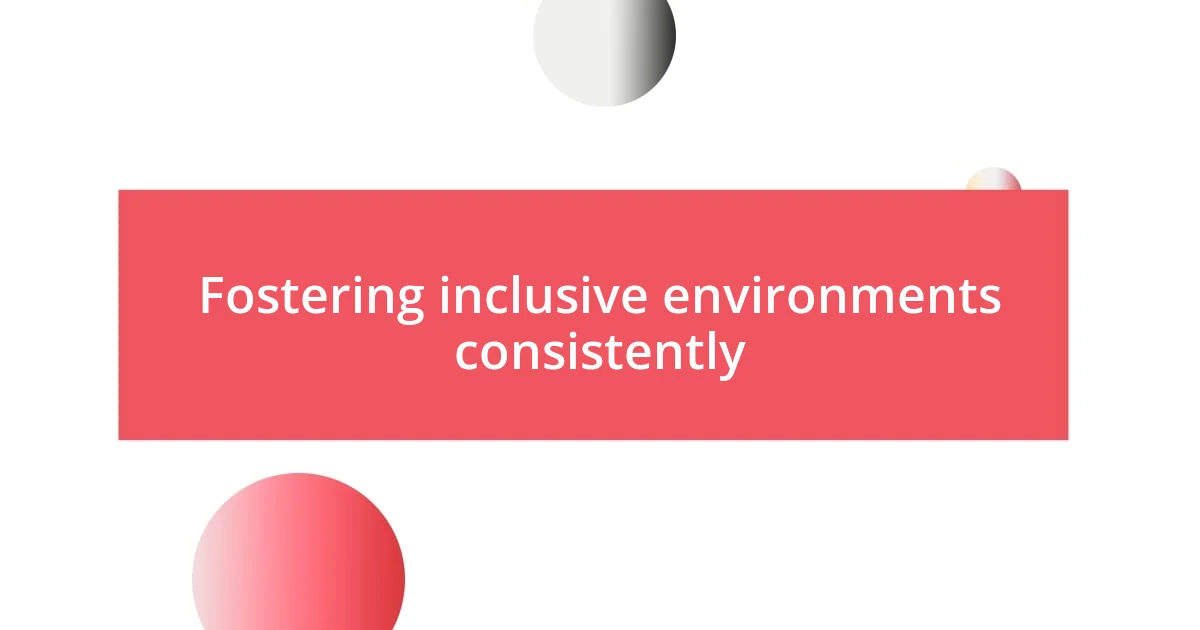Key takeaways:
- Creating space enhances connections by allowing deeper reflection, trust, and meaningful exchanges in conversations.
- Recognizing the needs of others through active listening and non-verbal cues fosters a supportive environment and strengthens relationships.
- Establishing emotional boundaries is essential for personal well-being, allowing for compassionate support without emotional burnout.

Understanding the importance of space
Space is more than just a physical expanse; it’s a vital component in fostering genuine connections with others. I remember a time during a group project when I deliberately took a step back, allowing my team members to share their ideas without interruption. That moment transformed our collaboration, revealing their strengths and creativity in ways I hadn’t anticipated. Have you ever noticed how giving someone room to breathe can lead to unexpected brilliance?
Creating space isn’t just beneficial for others; it enriches our own experiences too. When I allow quiet moments in conversations, I often find that the silence encourages deeper reflection and more meaningful exchanges. It’s intriguing how these pauses can be just as powerful as dialogue. How often do we overlook the impact of silence in our interactions?
Ultimately, understanding the importance of space means recognizing its role in emotional well-being. I’ve seen how offering someone a safe, open atmosphere fosters trust and vulnerability. Imagine the possibilities if we all made a commitment to create these nurturing environments in our daily lives! Wouldn’t it be remarkable to witness the growth that flourishes in such spaces?

Recognizing the needs of others
Recognizing the needs of others often starts with truly listening. I once attended a workshop where the facilitator emphasized the power of active listening—it made me realize how often I might be hearing without comprehending. By tuning in and paying attention to subtle cues, like body language or tone of voice, I discovered that people often communicate needs beyond their spoken words.
Here are some ways to recognize the needs of others:
- Watch for non-verbal signals: Body language can convey emotions that words sometimes don’t express.
- Ask open-ended questions: Encouraging others to share their thoughts can reveal their underlying needs.
- Practice empathy: Putting yourself in someone else’s shoes can help you understand their experiences and feelings.
- Be attentive to changes: Notice shifts in behavior or attitude which might indicate a struggle or need for support.
I’ve found that when I focus on these aspects, I can create a more supportive environment where people feel valued and understood. It’s a continuous journey of learning and adapting, but the connections I foster along the way make it all worthwhile.

Building empathetic communication skills
Building empathetic communication skills is essential for fostering genuine relationships. I remember a moment during a difficult conversation with a friend. As I noticed her struggle to articulate her feelings, I changed my approach and asked open-ended questions instead of trying to provide immediate solutions. That shift in my communication style not only made her feel heard but also encouraged her to open up more, revealing deeper emotions. Have you ever found that a little patience can transform a potentially awkward situation into a breakthrough moment?
Empathetic communication also hinges on the ability to mirror emotions. For instance, when someone shares their experience, I often find it valuable to reflect their feelings back to them. If a colleague expresses frustration, I respond with something like, “It sounds like you’re feeling overwhelmed.” This simple practice not only shows that I care but also validates their emotions. It’s fascinating how quickly trust builds when the other person feels understood, isn’t it?
To further illustrate, consider how vital it is to remain present during conversations. I often catch myself drifting off mentally, especially when I’m distracted by my own thoughts or stress. However, when I consciously make an effort to engage fully—setting aside my phone and making eye contact—I notice a remarkable difference. My interactions become more meaningful, and I often walk away from these conversations feeling a stronger bond. Isn’t it intriguing how small changes in our communication habits can lead to profound connections?
| Empathetic Communication Techniques | Description |
|---|---|
| Active Listening | Focusing fully on the speaker, acknowledging their words without interruption. |
| Open-Ended Questions | Encouraging deeper conversation by asking questions that can’t be answered with a simple ‘yes’ or ‘no.’ |
| Mirroring Emotions | Reflecting back the feelings expressed by the other person to show understanding. |
| Being Present | Eliminating distractions to engage fully in the moment. |

Creating physical space in interactions
Creating physical space during interactions can greatly enhance the comfort and openness of those involved. I remember a time when I was in a crowded café, having a serious conversation with a colleague. I instinctively shifted our chairs slightly apart, creating a more intimate setting. This small act made it easier for both of us to express our thoughts without feeling constrained by the busy environment around us. Isn’t it interesting how a little extra room can lead to deeper conversations?
I’ve also found that being mindful of personal space is essential in various situations. Once, while attending a community meeting, I noticed someone standing too close, which made others visibly uncomfortable. Instead of pressing forward, I suggested moving to a larger circle where everyone could breathe a bit easier. This subtle adjustment transformed the dynamics of the discussion, allowing people to engage more freely. Have you ever experienced how the physical arrangement of a group can shift the energy in the room?
Furthermore, I believe that setting the right physical environment can significantly influence the quality of interactions. I often choose a cozy corner couch for one-on-one chats at home rather than a stiff dining chair. It’s as though the warmth of that space invites vulnerability. When people feel relaxed physically, they are often more willing to share openly. Isn’t that what we all seek in our conversations—a space where we feel at ease to truly be ourselves?

Establishing emotional boundaries effectively
Establishing emotional boundaries is a skill I’ve had to refine over time. I distinctly recall a situation where a friend constantly sought my advice but rarely took it. At first, I felt pressured to always be available, but I eventually learnt to say, “I care about what you do, but I need to step back now.” This small shift allowed me to maintain my own emotional well-being while still being supportive, demonstrating that boundaries are not just about distance; they are rooted in respect.
In my experience, understanding the difference between empathy and overextension has been crucial. I used to find myself getting overly involved in my friends’ issues, feeling their pain as if it were my own. It became overwhelming. By recognizing that it’s okay to feel compassion without absorbing their emotions, I began to create a mental “buffer zone.” This prevents emotional burnout and enables me to be a better friend. Have you felt the weight of someone else’s struggles dragging you down?
Moreover, I’ve realized that articulating my emotional limits clearly benefits my relationships. There was one time when I told a family member, “I’m here for you, but I also need to take some time for myself to recharge.” This openness led to a healthier dynamic, making our conversations more genuine. It’s so enlightening to see how setting boundaries not only helps me but also encourages others to do the same. How liberating is it to know that saying “no” can create space for “yes” in a healthier context?

Fostering inclusive environments consistently
Creating an inclusive environment is something I prioritize in every interaction. I vividly recall a workshop I attended where everyone was encouraged to share their thoughts. The facilitator made a point to invite quieter participants to express themselves. I was struck by how their simple gesture fostered a sense of belonging and allowed diverse perspectives to come forward. Have you ever noticed how just inviting someone to speak can transform the atmosphere?
Consistency is key when it comes to inclusivity. For instance, during team meetings, I intentionally ensure that everyone has an opportunity to contribute, regardless of their position. Sometimes, I even ask quieter members for their opinions directly, which not only empowers them but also enriches our discussions. It’s fascinating to see how regular practices can dismantle barriers and encourage collaboration—don’t you think it’s essential to make everyone feel valued?
Moreover, I realize that fostering inclusive environments requires ongoing reflection and adaptation. A while back, I received feedback that our space felt exclusive to certain voices. Rather than being defensive, I listened and adjusted my approach. By actively seeking out differing perspectives and being open to change, I can create a more welcoming atmosphere. Isn’t it rewarding to know that our efforts can continuously evolve, making our spaces even more inclusive?

Practicing self-care while supporting others
Practicing self-care while supporting others is truly a balancing act. I remember a time when I volunteered for a helpline and felt the emotional weight of each caller. I was eager to help but soon realized I was neglecting my own needs. To counter this, I developed a routine where I spent ten minutes after each call in quiet reflection. It was a small step, but it made a significant difference in how I felt moving forward. Have you discovered ways to put your well-being first amidst the demands of others?
Finding that personal balance is an ongoing journey. I’ve discovered the importance of scheduling time specifically for self-care, even when I want to be there for others. For instance, I decided to set aside Saturday mornings for my favorite hobbies—reading, gardening, or simply soaking in some sunlight. It transformed not only my mood but also how I show up for my friends and family. Does creating time for your passions rejuvenate your capacity to support those around you?
Moreover, talking about self-care can sometimes feel awkward, but I’ve found it opens up deeper conversations. There was a moment when I shared my struggles with a close friend, admitting that I sometimes felt drained by being the go-to person. The response was eye-opening; she echoed similar sentiments! This shared vulnerability made our bond stronger and encouraged us both to prioritize our mental health. How liberating is it to realize that embracing our own needs can enhance the support we offer others?















